Understanding Feline Body Language
Have you ever caught yourself wondering what your cat’s tail is trying to say? As much as we’d love to hear their thoughts, cats can’t speak our language, but they sure have a lot to communicate through their body language. One of the most expressive parts of a cat’s body is its tail. By paying attention to its movements, you can unlock a whole new way to understand your feline friend’s mood, needs, and even how they express affection. Let’s dive into the fascinating world of tail language!
Scientific Insights into Tail Language
Research has shown that a cat’s tail positions and movements, along with other body language cues like ear and eye positioning, play a crucial role in communicating emotions such as confidence, affection, fear, and aggression. This helps cats express themselves to both other cats and humans. (Source: PMCID: PMC8469685)
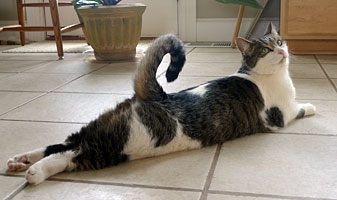
Why Observing Your Cat’s Tail Matters
Understanding your cat’s tail signals helps you prevent unpleasant situations like scratches or bites, especially if you have children or visitors interacting with your pet. It also allows you to reduce stressors that may trigger anxiety, such as excessive noise. If you have a multi-pet household, recognizing your cat’s body language toward other animals, like dogs, can be crucial in maintaining harmony.
The Cat’s Tail: More Than Just Balance
A cat’s tail plays a vital role in balance, especially when walking on narrow surfaces or making sharp turns while running. However, it’s also a powerful communication tool. By paying attention to your cat’s tail position and movements, you can gain valuable insight into its mood.
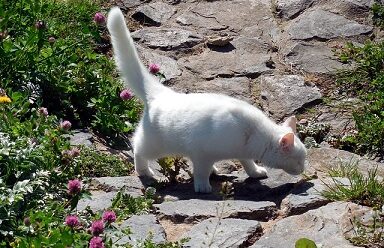
Cat Moods And Their Tail Positions
1. Confidence and Happiness
- Tail Wrapped Around You or Another Cat: A sign of trust, affection, and social bonding, showing confidence in their environment.
- Arched or Question Mark-Shaped Tail: A playful mood.
- Straight-Up Tail with a Hooked Tip: Your cat is friendly and affectionate.
- Straight-Up and Calm: Your cat is happy—often seen when you return home.
- Straight-Up, Shaky, and Fluffy: Extreme excitement, often before receiving a treat.
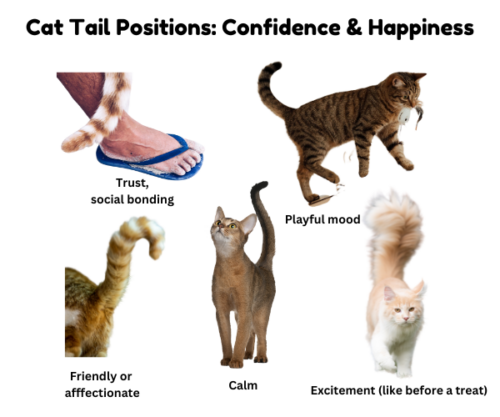
2. Neutral and Relaxed Positions
- Tail Aligned with the Back: A calm and content cat.
- Slowly Wagging Tail: A sign of affection.
- Slightly Firm Tail: Your cat is curious and interested.
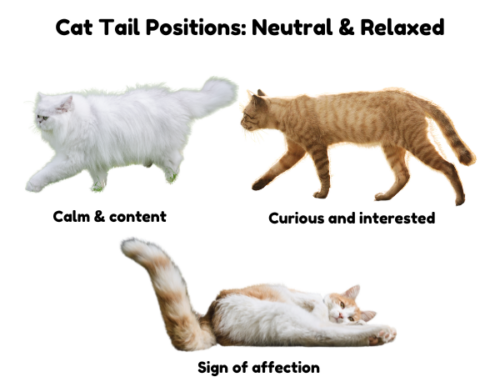
3. Caution and Fear
- Curved Down Without Bristle: The cat is cautious.
- Tail Down, Curled to One Side: Displays distrust in a situation.
- Tail Tucked Beneath the Body: Indicates fear and insecurity.
- Straight-Up and Bristled: Extreme fear or warning to back off.
- High in Diagonal and Firm: Indicates Uncertainty or cautiousness.

4. Irritation or Aggression
- High in Diagonal, Waving: A sign of irritation or mild aggression.
- Tail Hanging Straight Down: Possible aggression—avoid approaching.
- Curved Down and Bristled: Defensive stance, willing to attack.
- Straight-Up and Erect: Potential aggression.
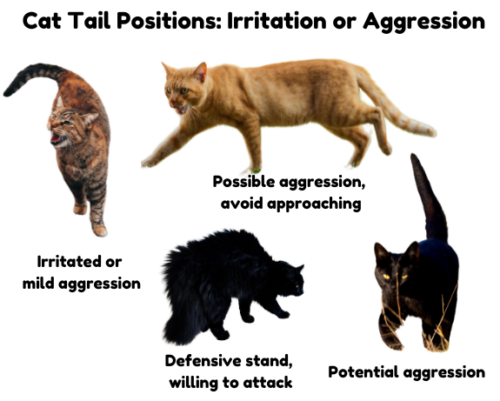
Tail Movements and What They Indicate
Warning Signs
- Whipping or Flicking Tail: Your cat is annoyed and signaling you to back off.
- Fast Wagging Tail: Fear or aggression, unlike dogs who wag their tails when happy.
- Bristled and Straight Behind the Cat: A sign of aggression.
Curiosity and Playfulness
- Slowly Moving Tail Back and Forth: Your cat is analyzing a situation, focus.
- Side-to-Side Tail Movements: Often seen when a cat is about to pounce on a toy or prey.
- Low Wagging Tail: A desire for affection.
Tail Movements During Sleep
Just like dogs, cats experience REM sleep, where they may dream (Jouvet et al., 1994) (source). Subtle tail flicks during rest could indicate they’re dreaming of chasing prey or playing. However, rapid or intense tail movements during sleep might be a sign of discomfort or a response to an external sound. If your cat is flicking their tail aggressively while sleeping, check for potential disturbances in their environment.
Tail Injuries and Communication
A cat’s tail is an extension of its spine, and injuries can affect not only movement but also communication. Cats with tail injuries, nerve damage, or amputated tails may find alternative ways to express emotions, such as more pronounced ear movements, vocalizations, or exaggerated body posture. If your cat suddenly stops using its tail to communicate or holds it awkwardly, it may indicate an injury that requires veterinary attention.
Beyond the Tail: Other Body Language Cues
While the tail is a strong mood indicator, it’s important to observe other body language signs:
- Ears Forward: Content or playful.
- Ears Flattened: Fear or submission.
- Ears Twisting Backward (Like Horns): A sign of anger.
- Ears Pulled Back: Indicates fear or discomfort.
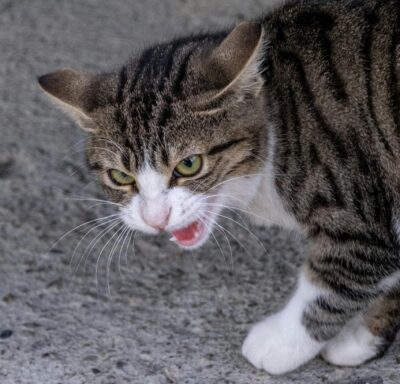
Individual Tail Communication Styles
While general tail signals apply to most cats, individual personality and breed differences can lead to unique tail behaviors. Some cats naturally carry their tails higher, while others may flick their tails more frequently when happy. Breeds like the Manx, which have little to no tail, rely more on body posture and ear movements to express emotions. Learning your specific cat’s tail habits over time can help you better interpret their personal communication style.
Strengthening Your Bond Through Understanding
By learning to interpret your cat’s tail language and overall body cues, you can build a stronger, more trusting relationship with your feline companion. This awareness not only enhances your bond but also ensures your cat feels understood and safe in its environment. So, next time you find yourself wondering what your cat is thinking, don’t guess—watch its tail!
Helpful Links:
—Hillspet: “The Tales Your Cat’s Tail Tell”
—East LongMeadow Animal Hospital: “How to Read Your Cat’s Body Language”
—PMCID: PMC8469685: “Heads and Tails: An Analysis of Visual Signals in Cats, Felis catus”
—Jouvet, M., Delorme, F., & Sakai, K. (1994). “Sleep patterning and behaviour in cats with pontine lesions creating REM without atonia.” Journal of Sleep Research, 3(1), 27-42.
Some content contains affiliate links or samples for reviews; I may receive compensation. Learn more
Leave a Reply